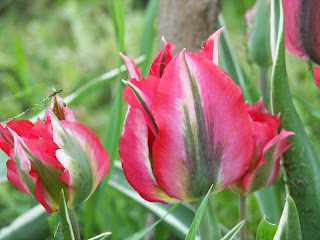


On April 2nd, I gushed about my spring flowering bulbs in the article "Two Lips Are Lovely." Today is not an actual gush but more a preparatory gush. Never had a preparatory gush? Well, hang on to your bulb catalog and let's fly!
Before all the foliage in your beautiful gardens die back, take the time to note where you want to plant spring flowering bulbs. A little spray of latex paint on top of your mulch or soil will mark the spot until it's time to plant.
Spring flowering bulbs can be planted under deciduous trees and bushes (if the digging doesn't hit roots.)
You may want to plant where the dieing foliage doesn't show as much: Where other plants will fill in around them (hostas for example), towards the back of the border, or in a wooded area.
Many catalogs have pictures of naturalized spring bulbs. Naturalized can mean different things. It may mean you plant a bulb and it reproduces developing into a colony of flowers. It may mean the flowers will look like they came up of their own accord and were not specifically planted by the gardener. It may mean they come up in wooded or other wildflower areas. It may mean they dig their bulbs after bloom and replant new in the fall.
The problem with naturalized looking spring bulbs, you must wait until the leaves die back of their own accord. If you've planted them in lawn grass, that grass will be way past needing mowed before they die back. Crocus tend to die back fast and may work in this instance - others, such as the larger plants, die back over a longer period. Cutting the foliage back or tied into those cute little bundles will not allow the nutrients into the bulbs to provide next year's flowers. The leaves need light until they have finished this process.
Spring flowering bulbs look best if planted in groups and not in straight lines. That's an opinion of course.
The bloom time of spring flowering bulbs can be extended for several months by choosing based on bloom time. Some bloom so early, they often come up in the snow. Others, are just winding down as other late spring plants start their show.
There are many heights, many uses, many forms, some fragrant, all can be used in vases and MANY MANY colors.
Here are some things to ponder:
Most spring flower bulbs are perennials in our area. Although, some are considered short-lived (2-5 years). Hyacinth and tulips are considered short-lived. That's why you need to keep planting every fall if you want to continue an array every spring.
Although we've discussed naturalized beds, there are other themes you may want to consider:
1. Color: All one color palate, different shades of one color, all pastel, all bright, two colors or three, patriotic, an artist's garden like Monet and etc.
2. Size or form: All fringed, doubles, tall, short, branched, parrots, and etc.
3. Flowers: A variety of kinds, one kind, different bloom periods, hybrid, heirlooms and etc.
4. The "Wave": Planted in curved lines (waves), one color or type blooms and about the time it quits, another wave of another color or type is in bloom. If the waves are deep enough, the effect can be stunning.
5. Cost: The best way to figure cost is divide the number of bulbs by the cost per bag. Figure if the plant is short-lived or long. Does it multiply (make new bulbs)? What is the cost for the enjoyment each bulb will bring to you? This like trying to put a cost on love.
I figure the cost per bulb but I also compare the cost vs. annuals. Some call this rationalization, I prefer to call it smart shopping. If a one year plant costs $5 and I can get 50 years from a $5 bag of 5 daffodils - call me smart. Or call me rationalizing smart - whatever.
6. Cost vs. quality: Cheaper bulbs are typically smaller. This doesn't mean bad. It means they may be smaller flowers until they grow larger over several years. It may mean they have a few duds. It may mean they have a few that are miss color coded. For most of us it simply means a bargain.
As you can afford, try some really large beautiful and perhaps unusual bulbs. I can't guarantee it won't get you hooked but there is a reason they are more expensive.
I've also enjoyed heirloom bulbs. They have a history that appeals to me and my old farmhouse yard. A good site is http://www.oldhousegardens.com/ They have heirloom bulbs, the history, where they are harvested (that means not stolen from protected sites), and a newsletter with boat loads of interesting stuff for the heirloom enthusiast.
7. Planting: Plant the exact depth the directions tell, pointed end up, do not use bone meal if you have dogs, do not pack soil hard over them, mulch, water in if it's been dry, and do all this at least a month prior to the first hard freeze.
If you have voles or moles, one solution is to plant bulbs in a chicken wire cage. Just make sure the soil is loose enough to go into the cage so there is no air pocket.
I also mark where I plant bulbs or I am forever digging them up in summer when I'm finding a place for new plants.
If you are a garden enthusiast, I guarantee the work put in planting bulbs in the fall will fade from memory when all those bulbs become flowers next spring. The first tulip to bloom in my garden brings with it the winter-buried feeling that my hopes of a better tomorrow just became possible.
“The day the Lord created hope was probably the same day He created spring.” Bern Williams
No comments:
Post a Comment